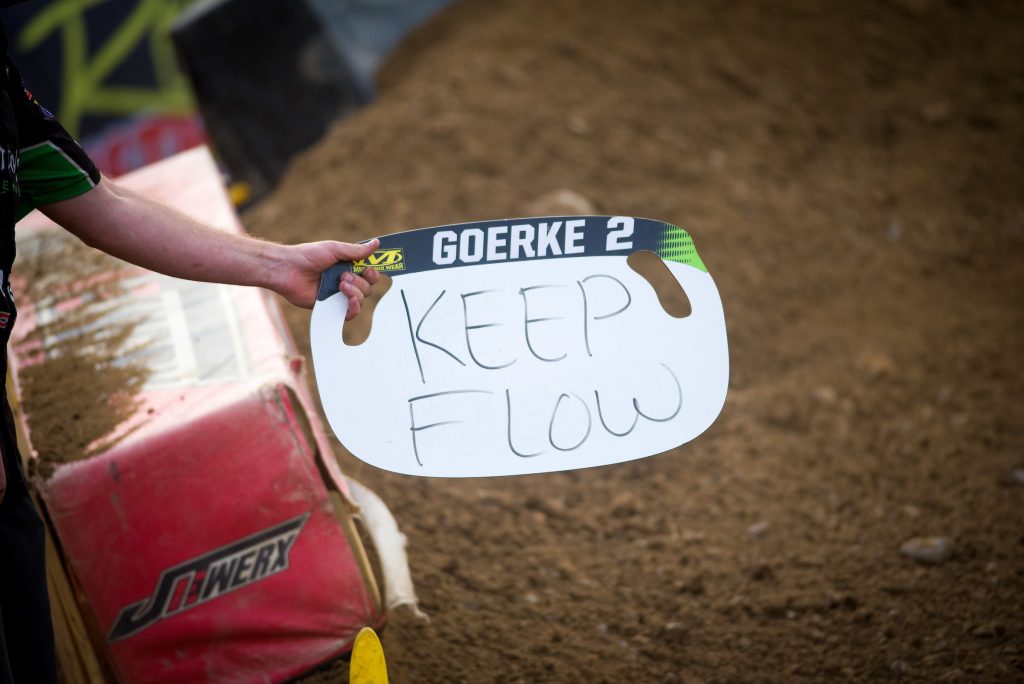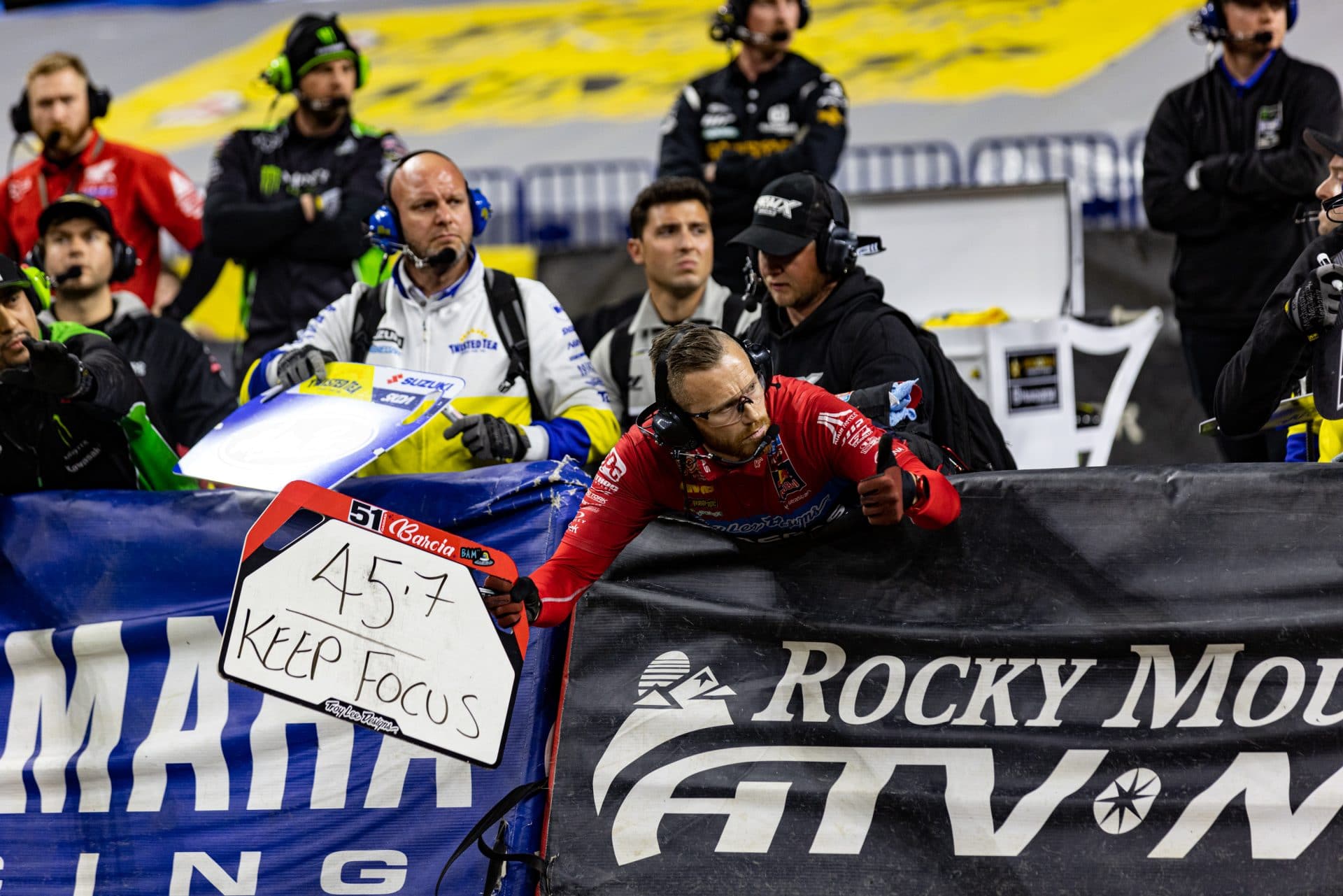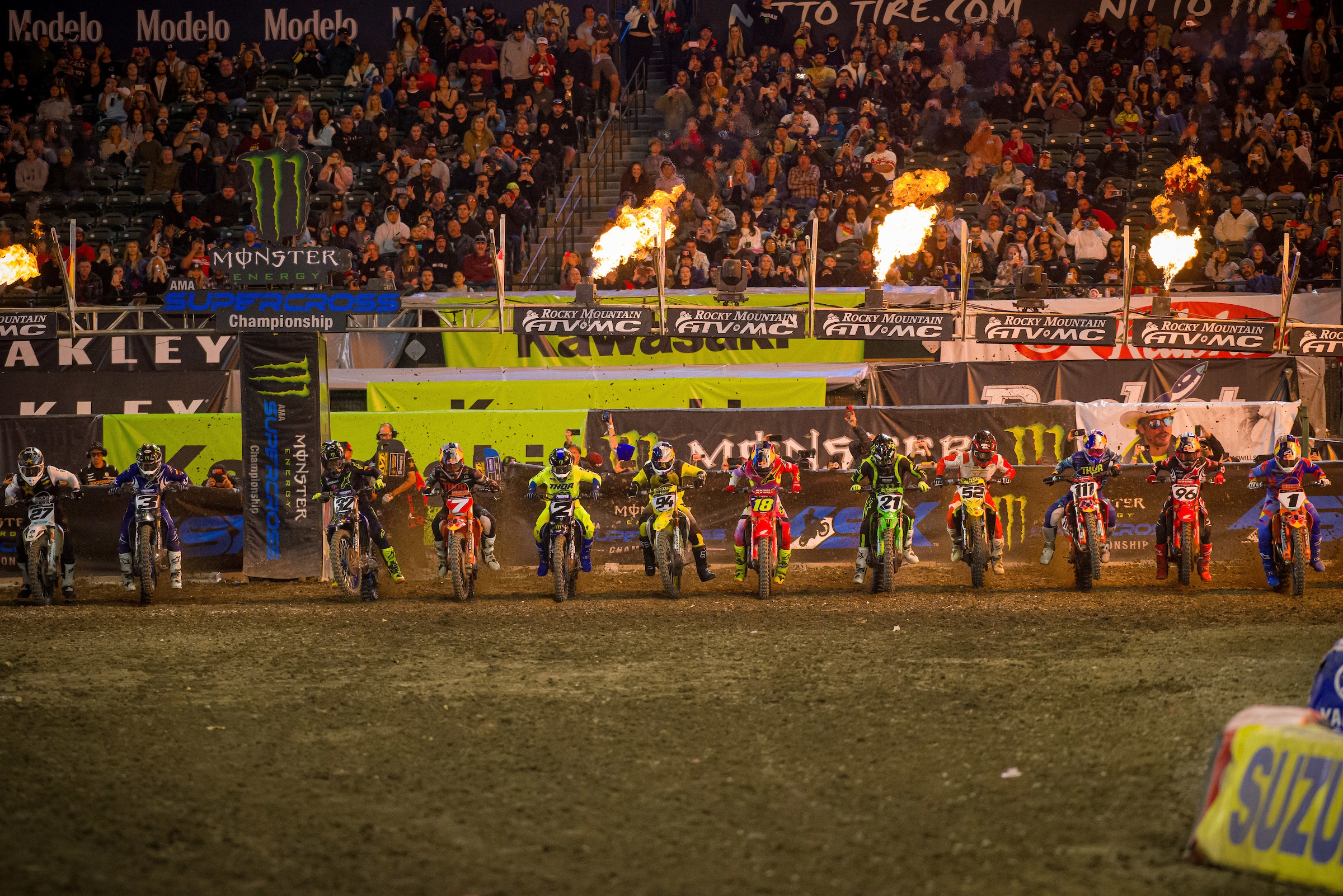
Whether you’re watching your favorite dirt bike race on the television or you’re fortunate enough to experience an event in person, you may have seen a small group of people standing behind a makeshift wall or fence at a specific part of the track. They’re usually holding what we call a pit board, out for their rider to read a message as they go by. Seems like a great idea on paper but let me give you a little insight into this oh, so important piece of equipment.
The mechanic’s area, or lack-there-of, at some of the places I’ve been, is usually a small little area roped, fenced, or barricaded off from the racing surface. The mechanic will hold out the pit board with a message written on it in hopes the rider is able to receive the information as they pass by. If you’ve ever tried to read a pit board while you’re racing by the mechanic’s area, you may have realized what seems like such a simple task is a lot harder than it looks. It is the mechanic’s responsibility to present the message in a clear, legible manner. It must be large enough to read from a distance and at speed, yet small enough to fit the words needed to get the point across without writing a novel. Short, subtle, to-the-point messages are best.

An actual mechanic isn’t as common at the amateur level, so sometimes you may see Dad or the significant other out there helping on the line and working the pit board for the duration of the moto. Things like the rider’s position or “go faster” are quite common among the non-professionals and in most cases, it’s mostly words of encouragement.
In the professional ranks, the pit board becomes a very significant and often critical tool that is used to provide extremely valuable information to the rider. There are certain riders that prefer words that will trigger an action, such as breathing, standing up, or focusing. Rather than simply writing the word “breathe” or “stand up”, I have found it to be more effective with most riders to use a different word that associates with those actions. Requiring them to see it, have to think about it, and initiate the action all without removing their focus too far from the task at hand. When you write something common, or that they’ve seen on the board for most of their career they are more apt to see it and not have it register. I like to use the words “exhale” and “legs”, simple, but just thought-provoking enough to ensure action is taken.
Sometimes riders prefer to have times put on the board. It can be their lap time, moto duration/time remaining, or a split to the rider ahead or behind. You may notice that the top-top guys predominately use lap times. Often, the mechanic will write their lap time and then underneath, the lap time of who they’re chasing or who is chasing them. These are the guys that are at the top of the game, they understand what they need to do for them to be successful and the reminders to breathe, focus, etc. aren’t needed. The goal here is to replicate another day at the test track where they are racing only the clock and their own lap time. This encourages focus, limits distractions and when done proficiently, usually results in a good finish.
We’ve seen it numerous times, but you may not have recognized what you’re witnessing. A rider will get out front, build up a lead and then just maintain the distance between themselves and second position. This is textbook execution of how to manage a race and is something only a few in our sport have mastered. At the professional level, this is where the pit board becomes an invaluable piece of equipment. Once the rider moves into the lead, in a perfect world, they’ll put down some sprint laps. They will already have a clear understanding of what their average lap time is on this certain track, and when they come around their board will notify them if they have indeed turned some faster laps to build a comfortable lead. Continuing life in that perfect world, their board will read something along the lines of +3 or more, indicating the split back to second position is three seconds, and underneath, will be their lap time. Now, each lap after will show their time and the time of the rider chasing and it is up to them to maintain those times and be aware of any changes. This is where pacing comes into play. By exerting just enough energy needed to maintain the split, they are not only conserving but will be able to up the pace if necessary.

Now, regardless of if you’re an amateur rider, or you race professionally, the task of actually reading these things can be a whole other issue in itself. Trying to focus on what you’re doing, and/or being aware of the rider(s) around you, all while turning your attention to some squiggly words written on a small board as you go by as fast as you can, often leads to missed messages or information. As a pro, you naturally become better at seeing and receiving the message on your board. But, close your eyes and come with me for a minute. Picture yourself racing with 40 others, you didn’t get a great start, and you’re in 22nd position. You come around to the mechanic’s area and there is an abundance of pit boards scattered throughout your vision, now you must decipher which one looks like yours and read the message all before you’ve gone by. Now open your eyes – Wait, what? Ha! Exactly. Seems impossible, right? But, for the most part, the mechanic and rider will have worked out where he will stand and where the rider will look, and/or their board may have a special color, or marking on it for the rider to recognize it quickly. However, there are definitely instances where the rider may miss reading the board due to being in a battle or overtaking a lapper. It’s unfortunate when there is an important message to deliver on the board but you just play the hand you’re dealt and try again the next lap.
I’ll never forget when I first started working Arenacross. With a lap time of 20-30 seconds, you don’t have very much time to write, deliver, clean the board, watch, and write something new before your rider comes back around again. You basically have to have things in your head ready to write without thinking about it, unless something happens on the track that requires a specific message. That was a steep learning curve because things happen exceptionally fast in that form of racing, but man, AX boarding is intense!
The supercross mechanic area is also pretty damn intense, the lap times are about double what the AX guys turn but there are also double the number of mechanics. Which are all professionals, attempting the same job as you are. Not to mention, some of the guys standing next to you are long-time decorated mechanics that you’ve idolized for years. In my early years, I’d spend just as much time doing my job as I would watching those guys do theirs, just trying to sponge up whatever I could to become better and more efficient. Monkey see, monkey do.
Monster Cup in 2013, Tony Berlutti (legendary and well-accomplished mechanic) and his rider were beside my rider and I on the line. As we went back to grab our bags and boards, his had fallen behind my bag. He went to grab it, but I grabbed it as I picked up my bag and went to hand it to him. He had this stern look on his face and my stomach sank, shit! what’d I do?! And he says “hey, thanks, man!” Phewww! I had a poster (Yes, a mechanic poster) on the wall at the shop I worked at where I cut my teeth in this world. I looked up at that picture on the wall almost daily, envisioning myself becoming “one of those guys”. It was Mike Gosselaar (another legendary mechanic with umpteen championships) and Tony Berlutti posing beside their Factory Suzuki’s in a One Industries ad. And there I was handing THAT guy his pit board, having my own moment and realizing these guys are just rad dudes that happen to be pretty good at working on dirtbikes.

There is an unwritten etiquette in the supercross mechanics area that I learned quite quickly – generally, you find your spot on the row and you share that spot with a mechanic whose rider is several positions away from your rider. You’ll alternate in and out as your rider goes by, and once they do, you back away from the line and relinquish your spot for the other mechanic. An experienced mechanic will automatically be on board with this, and as you step back and forth, you are bumping into each other, tripping on the dirt, etc. But that experienced guy will just be there helping to hold you up, and vice versa without even looking at each other because we are focused on our rider on the track. It’s just one of those things that ya don’t know, til ya know.
The ol’ pit board has had a different significance in my life than most, but, it’s proven time and time again that just a simple message can help any rider. The young, up-and-coming amateur, all the way to the old wily veteran. A subtle reminder to stick to the basics, maintain focus or regain composure after a fall, or to just let them know they’re doing a great job out there. That little whiteboard can be of substantial benefit. I’ll leave you with my all-time favorite – “Breath” without the E.
P.S. T-Dags, I’m sorry!

This week’s Dialed In column is brought to you by the fine people at Kimpex Canada. Kimpex is a multi brand distribution company that carries popular motocross and off-road brands such as Leatt, Arai Helmets, Muc-Off, and Ogio. For more information on products and dealers please visit www.kimpex.com.





